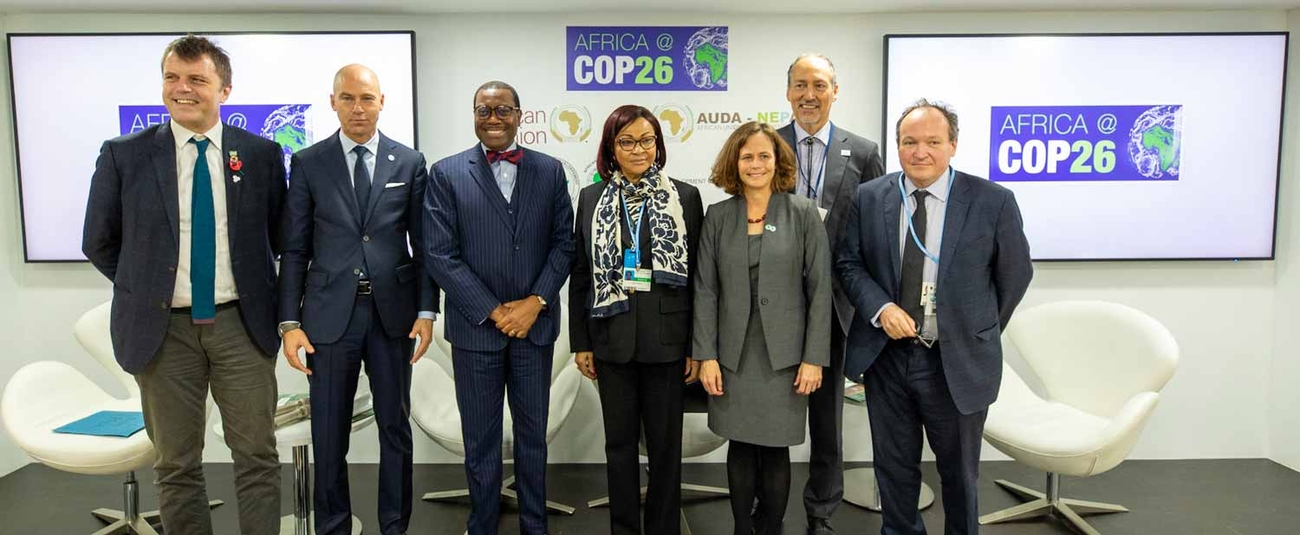
COP26: “Mission 1 for 200”, a financing facility for food and nutrition in Africa, will give African farmers support to adapt to climate change
10 November, 2021A financing facility for food and nutrition in Africa that has the backing of African governments will be a game changer for mobilising finances and technology for African smallholder farmers who bear the brunt of climate change-induced negative impacts.
"Mission 1 for 200," as it has now been redubbed, aims to increase access to an affordable and nutritious diet by Africa’s food insecure populations and deliver climate resilient technologies to 40 million farmers, African Development Bank president Dr. Akinwumi A Adesina said during his presentation of the facility on the sidelines of the COP26 summit on Monday 8 November.
The African Development Bank, together with governments and development partners have given a nod to the financing facility that has the ambitious goal of mobilizing $1 billion to feed 200 million people in Africa by 2025.
“This facility will actually allow us to produce 100 million metric tons of food, enough to feed 200 million Africans…allowing us to cut down hunger in Africa by 80%,” Dr Adesina said. “The vision is clear. Together let’s achieve zero hunger in Africa,” he added.
Dr. Adesina spoke at an event titled Financing Agriculture Adaptation in Africa, co-hosted by the African Development Bank and the International Fund for Agricultural Development (IFAD), at the COP26 Africa Pavilion in Glasgow.
The session included Professor Moussa Baldé, Senegal’s Minister of Agriculture and Rural Equipment; Josefa Sacko, Commissioner for Agriculture, Rural Development,
Blue Economy and Sustainable Environment, African Union Commission; Patrick Verkooijen, CEO Global Commission for Adaptation; Carlos Manuel Rodriguez, CEO and Chairperson of the Global Environment Facility; and Roy Steiner, Managing Director of the Rockefeller Foundation.
Echoing Adesina’s remarks, IFAD President Gilbert Houngbo said technology would be the key to productivity and the “three p’s” - production, productivity and protection.
“It’s not about investing in food production – it’s about investing in the people behind the food production. We can’t wait. We have to start now,” he added.
Other panelists in the session discussed options for adaptation as a means to improve African food systems. Patrick Verkooijen, CEO Global Center on Adaptation, a Bank partner in championing the continent’s adaptation efforts through the Africa Adaptation Acceleration Program (AAAP) described the AAAP as one of the “boldest of the boldest African adaptation initiatives in the world.”
The financing facility, a component of AAAP’s blueprint, includes driving adaptation to reach 30 million African smallholder farmers.
“Financing climate change through adaptation will be much more cost effective than paying for crisis response, disaster relief…we need financing to flow and partnerships to deliver,” Verkooijen said.
African governments together on need to end malnutrition
In April, the Bank and IFAD hosted a High-level Virtual Dialogue on “Feeding Africa: Leadership to Scale-up Successful Innovations” attended by 18 African Heads of State who backed the idea of the financing facility.
Since the African Development Bank launched its Feed Africa Strategy in 2015, more than 74 million people are benefitting from access to improved agricultural technologies, Adesina said. Under its flagship program, Technologies for African Agricultural Transformation – or TAAT - some 11 million farmers, across 29 African countries have been provided with proven agricultural technologies in under three years.
Through TAAT, heat-tolerant wheat varieties grow across some 1.8 million hectares in Ethiopia, Sudan and six other countries. TAAT has increased food production by an additional 100 million tons annually - enough to feed 200 million more people, or 81% of chronically hungry Africans.
“The solutions exist but they are not reaching farmers at scale. The vision outlined here of mobilizing $1 billion to reach 200 million farmers to help them adapt to climate change is what we need to do,” said Dr. Beth Dunford, the Bank’s Vice President for Agriculture, Human and Social Development, in her session closing remarks.
.embed-container { position: relative; padding-bottom: 56.25%; height: 0; overflow: hidden; max-width: 100%; } .embed-container iframe, .embed-container object, .embed-container embed { position: absolute; top: 0; left: 0; width: 100%; height: 100%; }
